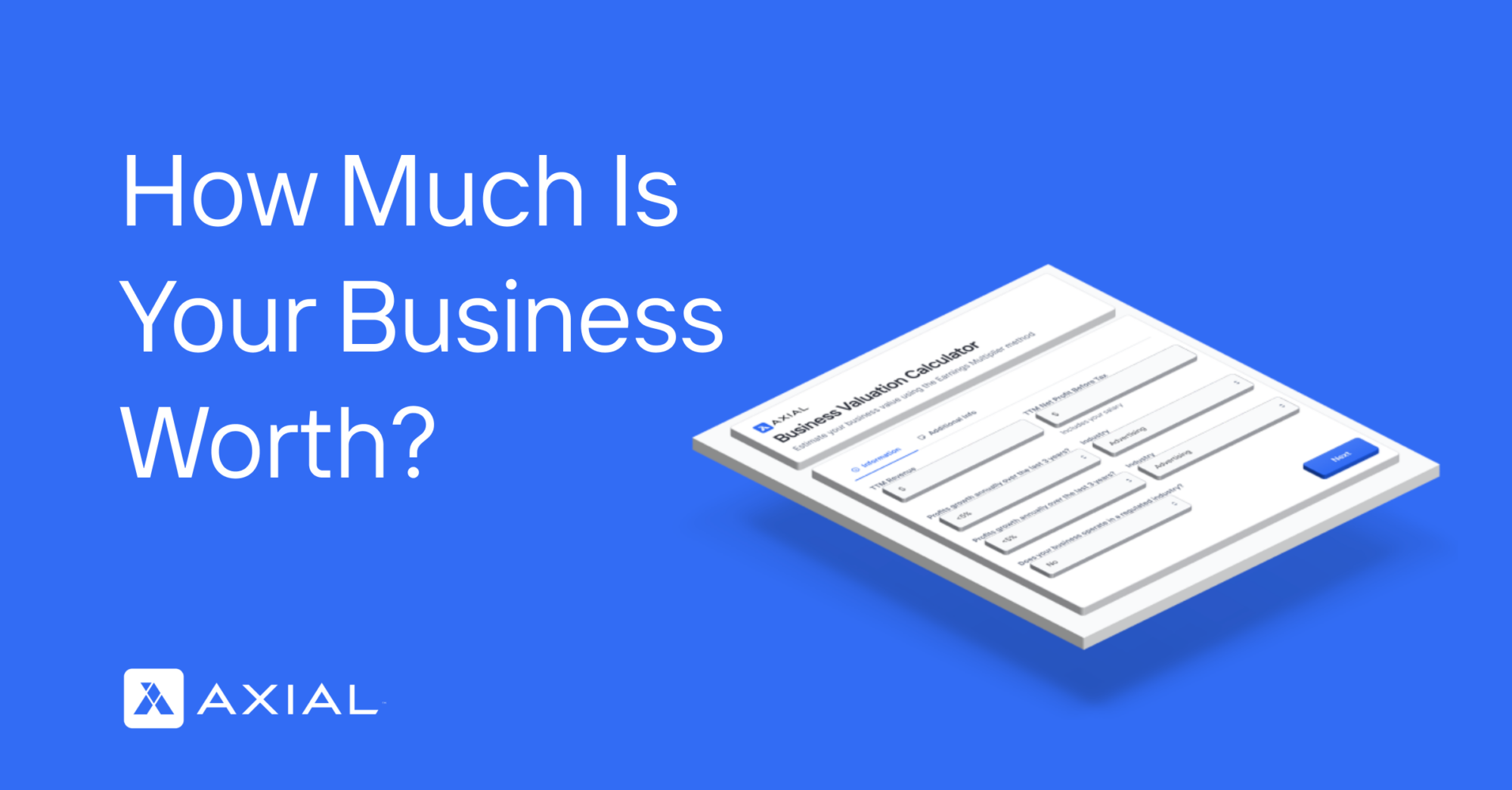
Introducing Axial’s Business Valuation Calculator – Find Out How Much Your Business Is Worth
The number one question our exit consultants hear from business owners is: “How much is my business worth?” To help…
An earnout represents just one of many contractual provisions structuring the sale of a business. That sounds pedestrian enough at first but, because this provision states that the seller can secure additional compensation in the future if the business achieves certain financial goals once sold, there’s a lot at stake. And the significance can run even deeper.
Earnouts are often used when the prospective buyer and the would be seller of a business have different views on its valuation at present and, more importantly, about how to factor into the price its post-acquisition potential. It’s not uncommon for sellers to expect lofty valuations; after all, many business owners have spent their lives building up the acquisition target with one eye on the exit while also hoping the sale preserves what they’ve built throughout their careers.
Disputes over valuation can kill a deal dead in its tracks. But the earnout provision can keep all parties at the table, mitigating some though not all levels of risk to executing the transaction. Before diving into the details — and the perspectives of Axial members who have used earnouts in recent transaction processes — some basics.
It’s essential to consider all these elements in order to ensure that the agreement is fair and equitable for both parties. And as Vishy Venugopalan and Vinay Bachireddy, both partners at Weave Growth Partners – an independent sponsor who has closed two deals on the Axial platform in the past year – have pointed out, “[Earnouts] also make sense when a business is hit by a one-time challenge but the seller believes they should get credit for normalized business performance as if the one-time hit did not occur.” The adverse effects on normal operations from the COVID-19 pandemic serve as a useful example of just such a situation.
“Earnouts are a type of structure in an acquisition where a portion of the price is tied to some future factor. This factor could be financials (e.g., revenue or EBITDA targets) or nonfinancial (e.g., retaining a key customer, securing a new license or regulatory approval),” Mathew Burpee, managing director with Kepler Capital Corporation, has explained. “Earnouts are most useful when they are used to either (A) increase the total valuation upside for the seller; or (B) address some sort of risk or finding that comes up in due diligence.” Kepler Capital closed one deal via Axial in 2021.
Likewise, Mike Stengle, managing partner with Exit Partners – an Axial 2021 Top 5 investment bank and a recent member of the 2022 Top 50 Industrials list – has observed, “We most often see earnouts used when a seller has implemented growth initiatives that are showing on the expense line but not on the revenue and profit lines. For example, a new product or service line that is just now being introduced. To our clients in this situation, we tell them that ‘the buyer will pay you now for what you have done and tomorrow for what you will do’ as it pertains to earnouts.”
And that’s about as useful a heuristic as any for understanding earnouts, but how is this provision typically structured in a deal?
An earnout can be structured in a number of ways, but typically this provision will include a base amount to be paid at closing, followed by either a one-time lump sum or installments over a set period of time. Although convention suggests a window of usually three to five years, Axial’s data on this aspect of earnouts — unpacked in greater detail below — reveals that this window may well be shrinking across the LMM. All the same, earnouts are based on the business achieving certain financial milestones going forward.
“There are infinite ways to structure an earnout, which is both an asset and a drawback to the structure,” Burpee has reasoned. “I think it is important to keep the earnout focused on areas where the seller will have some influence or control post-closing and to keep the calculation as clear and simple as possible. If you spend time arguing about the earnout post-closing, you take away time from growing the business.”
Buyers often use earnouts as a way to incentivize sellers to stay on board during the post-closing period to help ensure a smooth and successful transition. In some cases, private equity firms may also use earnouts to finance part of the purchase price. As a result, earnouts can be complex.
“We have valued businesses as a multiple of EBITDA overall, and allocated some portion of the total purchase price to an earnout that is contingent upon the business being at or above a certain level of financial performance after the deal closes,” Venugopalan and Bachireddy remarked. “We typically hold investments for about five years, and earnouts have typically been paid a year or two after close. We typically use earnouts as downside protection to mitigate against any deterioration in the first year or two after a change of control.”
With their ability to keep a deal on track, earnout provisions have grown in use over the past several years. Moreover, their use has been spurred along by private equity firms doing more deals across the LMM than ever before. A recent American Bar Association Private Target Mergers and Acquisitions Deal Points Study found that approximately 27% of deals included earnout provisions. The study examined 151 transactions valued between $30 million and $750 million from 2018 and the first quarter of 2019.
“I can only speak for my experience, but I would guess that ~25% of our deals have an earnout,” Burpee has observed.
Venugopalan and Bachireddy have gone even further, prompted in part by the pandemic, including “earnouts in all our LOIs because we strongly prefer that the management team stays in place and that key managers are sufficiently incentivized to execute after the deal has closed. Throughout 2020-21, the COVID-19 pandemic caused a one-time financial hit to many businesses even as the M&A markets were strong. We used earnouts as a means of risk-sharing while also trying to meet the seller’s valuation expectations, and we expect other buyers did so as well.”
And Axial’s data confirm a number of trends, with some novel findings emerging from 30 transactions conducted via Axial that have included earnouts over the past two years.
Total Enterprise Value (TEV):
Earnout Amount:
The median earnout represented 23.2% of the median TEV of the 30 companies sold, while the average earnout represented 19.8% of the average TEV. Perhaps even more remarkably, buyers have committed nearly $50 million in aggregate to earnouts over the past two years across the 30 deals behind Axial’s earnouts data. That figure represents 18.1% of the summed TEV for all 30 of the companies sold.
Finally, the time between a deal’s closing date and when an earnout provision is paid, either in full or via a first installment, reveals some remarkable symmetries across transactions regardless of TEV or earnout amount. While some provisions stipulated as little as six months on the low end, others took all the way up to 20 months on the high end. And the median time between close and earnout due date was 12 months — a far cry from three to five years. Similarly, the average time between close and earnout due date was just under 13 months.
The ramifications of this increased use of earnout provisions could significantly impact the banking and legal industries serving the LMM for sometime to come. But much of that remains to be seen in part since many of the earnouts on recent deals have yet to come due.
As Scott M. Bushkie, managing partner of Cornerstone Business Services – an M&A advisor whose proven success is shown through two appearances in 2022 Axial League Tables, a feature in the 2022 Axial Industrials Top 50 and yet another acknowledgement in 2021 League Tables – has argued, “earnouts are probably the most litigated structure within a deal. As a result, the litigation side of the industry will like it but likely not the M&A attorneys themselves. Earnouts can force these lawyers to cover every ‘what-if’ scenario, which is close to impossible. On the other hand, banks may like them as it is not a guaranteed payment and it helps mitigate key risks identified in the business.”
